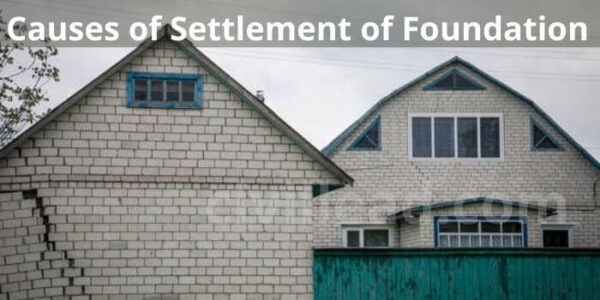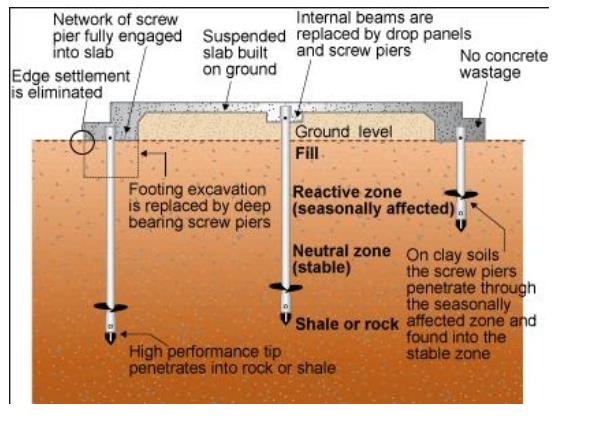Skyscrapers towering hundreds of stories high. Bridges spanning miles across bodies of water.
Highways traversing unstable terrain. What do these impressive feats of engineering have in common?
Their stability and shear capacity rely on deep foundation systems securing them firmly in place below ground.
When substantial structures can’t depend merely on traditional, shallow footings to provide the necessary support, civil engineers employ ingenious methods of developing deep foundations.
These extend well below the surface through weak surficial soils to substantial load-bearing stratum.
This enables tremendous weights above ground to be reliably borne and resist overturning or lateral forces from wind or earthquakes.
Deep foundations support immense structures by transferring loads to stronger subsurface strata.
Civil engineers employ the strength and stability of deep foundation systems to construct today’s largest structures.
But how do these subsurface supports achieve what shallow footings cannot? Let’s delve into the depths and explore what comprises a deep foundation’s exceptional capacity.

5 Types of Deep Foundation
While varying in composition and construction method, the five primary deep foundation types include:
Driven Piles – Sturdy columns hammered into the ground. Common versions are precast concrete, steel H-piles, or timber.
Drilled Shafts – Reinforced concrete piers installed via subsurface excavation without casing tubes.
Caissons – Watertight retaining structures enabling excavation below the water table for placement of concrete piers or piles.
Micropiles – Small diameter drilled piles with steel reinforcement that can access tight spaces and difficult terrain.
Helical Piles – Manufactured steel cylindrical shafts containing one or more helical bearing plates to slice into the earth when twisted into place.
Deep Foundation Design
Here are some key aspects of deep foundation design:
Site Investigation
Thorough site investigation is crucial to collect geotechnical data about subsurface conditions which will inform the design. This includes:
- Soil borings to determine different strata, their engineering properties, density, bearing capacity
- Observing depth to bedrock
- Identifying groundwater table level
- Testing for compressibility via settlement analyses
Load Considerations
The expected loads and their transfer to the subsurface is determining for deep foundation selection and design. Important loads include:
- Dead loads from structure weight
- Live loads like occupancy, wind, seismic
- Uplift forces
- Lateral loads
The intensity, eccentricity and direction of loads influence the depth, type, size and reinforcement required for the deep foundation system.
Foundation Choices
With load information and soil data, engineers can select fitting deep foundation types. Common choices include:
- Driven piles (precast concrete, steel, timber)
- Drilled shafts with bell bottoms if in clay
- Helical piles for restrictive sites
- Groups of piles with pile caps
Then appropriate depth, spacing, diameter and reinforcement are designated in accordance with the geotechnical recommendations and loading the site’s subsurface can withstand.
Field Testing
Test piles installed early on allow evaluating capacity via:
- Load tests to failure
- Monitoring pile head movement from test loads
- Integrity testing for continuity
This confirms the foundation’s ability to transfer estimated loads without exceeding site-specific bearing, friction and settlement limitations.
Refinements can be made before final foundation construction proceeds.
Ongoing monitoring during and after construction ensures deep foundation elements achieve target design performance criteria.
Deep Foundations vs Shallow Foundations
While sharing the duty of stabilizing structures, deep and shallow foundations differ significantly in their mechanics.
• Depth – Deep options extend through weak surface layers to bear loads in stronger, deeper substrata. Shallow foundations rely solely on upper soils a maximum of 6 ft. down.
• Geotechnical Limitations – Deep foundations performed better in subsidence-prone areas or poor soils. Shallow systems require properly consolidated substrata.
• Friction and Bearing – Deep foundations use both the shaft friction through strata and end bearing pressure. Shallow footings employ primarily bottom bearing pressure.
• Load Types – Deep systems handle heavy axial loads better. Shallow ones typically suffice for lighter structures or lateral/tension loads.
The depth and enhanced capacities explain why civic structures utilize deep foundations to assure stability.

Advantages of Deep Foundations Over Shallow Ones
Why design massive structures on deep versus shallow supports? Key perks include:
• Greater Load Strength – Bear loads of thousands of tons across skyscrapers and bridges safely to bedrock.
• Support When Shallow Layers Compromised – Transfer loads through weak soils to competent strata like bedrock.
• Minimizes Settlement – Extend past compressible clays into dense sand or bedrock that won’t consolidate much under loading.
• Resist Overturning and Lateral Forces – Essential for skyscrapers and offshore structures battered by wind/wave loads.
• Feasible When Water Table High – Caisson foundations enable excavating dry shafts well below the water table level.
For super-sized structures, deep foundations outshine shallow footings regarding strength, resiliency, and feasible applications.
Typical Deep Foundation Depths
How far down must engineered deep foundations reach to hit suitable bearing strata? Some typical design depths include:
- Skyscrapers – 100 to 400 ft. to reach bedrock able to support immense dead and wind loads
- Bridges – Driven piles of 50 to 250 ft. depth to constrain buckling and sway
- Residential – Helical piles needing only 15 to 30 ft. depth in clay or dense soils
- Towers – Intermediary depths around 60 ft. for ample wind/compression resistance
Depths vary substantially depending largely on soil conditions and overall structural loads. Offshore piles may embed hundreds of feet into the seafloor to firmly anchor offshore platforms against storms and waves.
Load Transfer Mechanism
Unlike shallow footings only relying on bottom pressure, deep shafts utilize two load transfer mechanisms:
Tip Resistance – The ultimate bearing capacity pressure exerted on the pile tip embedded in a strong bearing layer.
Frictional Resistance – Shear stresses along the full inserted pile length as surrounding soils adhere to the external shaft.
Friction piles rely significantly on the friction component to carry loads without reaching an end bearing layer.
However, friction fatigue can occur over time if the friction is overcome and the pile settles slightly, reducing capacity.
Design life considerations affect ultimate capacity targets.
FAQ – Deep Foundation Systems
What is deep foundation and shallow foundation examples?
Shallow foundations include strip footings, isolated footings, combined footings, mat foundations, and grade beams. Deep foundations include pile caps, piles, drilled piers, and caissons.
What materials are used for deep foundation?
Concrete, steel and timber are the most common materials used to make piles for the driven pile foundation method. Concrete piles are precast before they arrive at a construction site. Similarly, contractors order prefabricated steel and timber piles that they can drill directly into the soil with a piling hammer.
What are the methods of deep foundation construction?
Drilled shafts, also known as bored piles, are deep foundation elements created by drilling a hole into the ground and filling it with concrete or other suitable materials. This method is commonly used to support heavy structures or in areas with challenging soil conditions.
Conclusion
Deep foundation systems make feasible today’s towering skyscrapers, mighty bridges, and mass-scale structures by funneling immense loads to durable subsurface zones shallow forms can’t access.
Understanding what comprises these varied deep supports, typical design depths, advantageous capacities, and how they uniquely transfer structure loads through combined friction and end bearing sheds light on an oft underground wonder of modern engineering.







